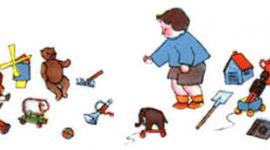Your Child's Temperament and What Each Type Needs to Grow

The following child temperament groupings represent identifiable clusters. However, not all traits are part of each cluster, and that 35% of all children cannot be represented by any cluster of traits. These traits are characteristics of reactivity: the child interacting in a certain way with the environment because the child has a certain predisposition to that behavior. The child's temperament is, in essence, his or her reaction to the environment.
Three Child Temperament Groups
Easy Child -- (40%)
This child can be described as positive, approach oriented, predictable, average intensity, and extremely adaptable. The "easy child" can fit almost any environment, almost any demands. Parents and teachers feel competent when working with an easy child, even grateful since the care of this child requires little time, effort, or attention.
Danger: Child's needs may be overlooked because they are so "good". Adult caregivers feel that they are experts on childrearing and fail to understand other situations.
Slow to Warm Up Child -- (15%)
This child can be described as passive, "shy", afraid of new people and situations, cautious, mild-mannered, negative, and slow to adapt. If this child is not given time to adapt, the time the child needs, a problem child will be the result. For every step this child is forced forward, he or she will take two steps backward. If, however, no demands are ever placed on this child, the child will not make any progress.
The slow to warm up child needs an environment where stimuli are presented gradually and repeatedly, in a positive manner, over and over and over and over. Danger: Too much pressure will increase the negativism. This child must be encouraged, never forced. This is a difficult child to "hurry up" and the child's responses to the demands of socialization will wear on adult patience. Flexibility is the prime requirement for the parent of a slow to adapt child. Otherwise, frustration with this child can create a great deal of anger.
Difficult Child -- (10%)
This child is unpredictable, withdrawing, non-adaptable to change, extremely negative and very intense. Nothing seems to work with a difficult child. Gradual and repeated demands presented with patience, consistency, and objectivity are required. Flexibility is the key attitude in coping with such a child. No one, however, should be with this child for extended periods of time.
Dangers: Without assistance, this child will receive nothing but negative feedback from his environment. Adults often communicate a host of negative feelings to the child such as hostility, impatience, or bewilderment. Parents feel
- threatened, anxious, guilty (they believe that they are unconsciously rejecting the child),
- resentful, or
- intimidated (inadequate, lost, hopeless, and confused.)
Parents must spend time away from this child to maintain sanity and perspective. Nurturing the difficult child is infinitely difficult.
See Also:
- What is Disruptive Mood Dysregulation Disorder (DMDD)?
- Conduct Disorder Interventions Help
- My Child Is a Sociopath! Is There Anything I Can Do?
No Matter What Your Child's Temperament, Remember These Things
All children must be accepted as is, with unique personalities and styles of behaving. Problems develop when the environment (or adults) put demands on the child which are not congruent with the child's temperament. When a child fits with the demands of his or her environment, that child grows. When the child does not fit, problems in interaction with that environment occur. Positive traits can be enhanced and negative traits can be subdued. The child's style of reaction, however, cannot be changed.
Adults, parents, and teachers can intervene between the child's personality and the demands of the environment. If a child is coping with the demands of the environment, it is a healthy situation and the child should be left to cope. If the child cannot cope with a situation and problems are developing, negative traits and behaviors intensifying, adults must intervene and change the demands of the environment. By understanding the child and accepting him the way he is, adults can structure the environment so as to enhance the positive traits and subdue the negative traits. When the child's problem behavior or symptoms reflect a reactive disorder, a change in the way the adult in charge functions can usually correct the problem.
Note: An adult's reaction to a child relies more on the values, goals, and standards of the adult than on the degree of congruence with the adult's own temperament. For example: Harmful attitudes toward a "difficult child" such as guilt, anxiety, and hostility and undesirable management practices such as impatience, inconsistency, and rigidity in unreasonable demands can be identified and corrected. The child will not change but the adult's reaction to the child's reaction will be altered and the number of problems will decline.
A child that is identified as lazy, inattentive and lacking interest may be a child whose restlessness and shifts in attention are to be expected if the child is highly active and distractible. Demands on the child to sit still or concentrate for long periods of time will be unreasonable. The child will need high activity outlets and may need to learn cues for returning to the task at hand.
Children can be taught ways to subdue negative traits. Mild-mannered children can be taught to speak up repeatedly until their needs are noticed. Non-persistent children should be encouraged to take breaks and breathers with a difficult task of often as necessary until the task is completed, rather than just giving up.
Why Does the Child Have This Temperament?
For many children, neurochemical imbalances can be the cause of difficult traits. These too run in families. ADD/ADHD children have many traits that are the result of a neurochemical imbalance. The proper medication can correct the imbalance and eliminate some "negative" traits. Medication can change a trait by correcting the biological defect that consistently causes that response.
The reactions of others to the child may be just as important as the medication.
For further study:
- Behavioral Individuality in Early Childhood, Thomas, Chess, Birch, Hertzig, and Korn, 1963/1971.
- Individual Differences in Children, Chess and Thomas, 1973.
- Temperament and Development, Thomas and Chess, 1977.
APA Reference
Gibson, E.
(2019, August 10). Your Child's Temperament and What Each Type Needs to Grow, HealthyPlace. Retrieved
on 2025, December 14 from https://www.healthyplace.com/parenting/challenge-of-difficult-children/goodness-of-fit-how-temperament-determines-need



